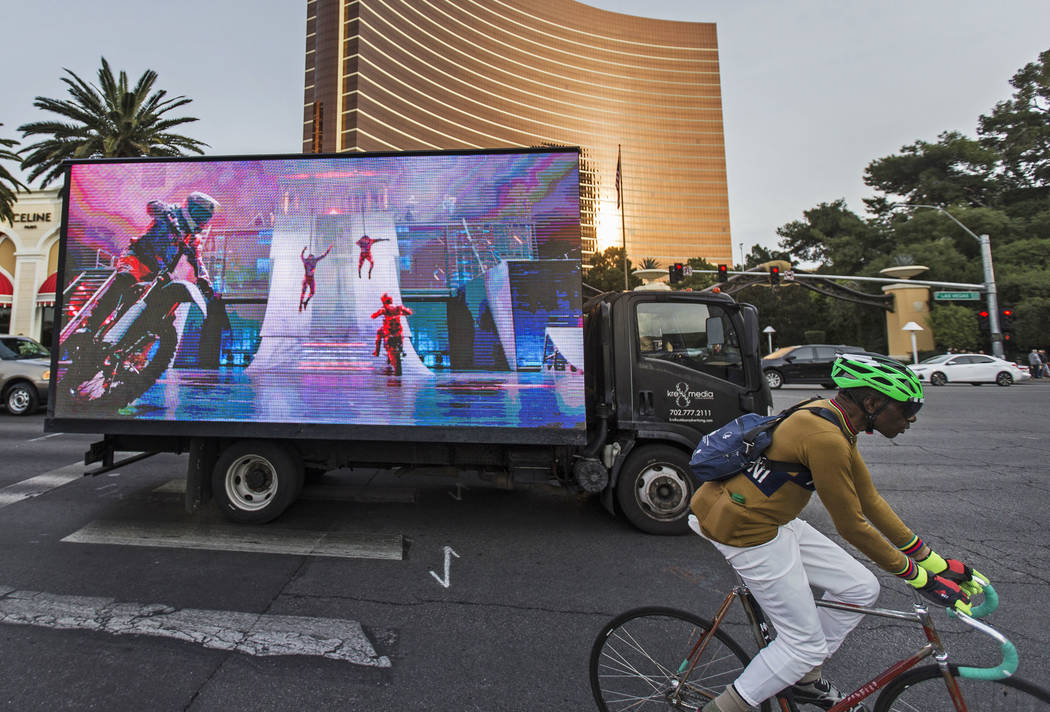Las Vegas Strip mobile billboards could soon face regulation

Long-unregulated mobile billboard trucks that have multiplied on the Las Vegas Strip may still carry their sometimes infamously risque invitations but would be subject to a host of new regulations under a proposed county ordinance.
The new law that is scheduled to come before county commissioners Tuesday would set guidelines for how mobile billboards may operate in what some are calling an unprecedented step to address an industry growing across the country.
“This would actually be the first comprehensive regulation of the mobile billboard industry in the entire United States,” said Jeremie Watkins, co-founder of Las Vegas-based Kre8 Media Outdoor Advertising, one of the largest and longest-running operators in Southern Nevada.
The proposed rules come as county officials seek to protect motorists and pedestrians on the Strip — and throughout unincorporated county territory — following previous safeguards undertaken in the gaming corridor such as pedestrian bridges and bollards.
“I would say that the paramount issue that has driven us has been safety, whether it is to the traffic on the roadways or the pedestrian,” said Commissioner Jim Gibson, the policymaker spearheading the plan.
Watkins said that rules specifically focused on safety were a positive for the industry and possibly a model for jurisdictions elsewhere. The ordinance also proposes an annual $500 licensing fee per vehicle that Watkins acknowledged would financially affect business, but “it’s a sacrifice we’re willing to make.”
Rules for the road
The proposed ordinance would create a new chapter in county code outlining a lengthy list of rules for operators, including requirements they register vehicles in the state; ensure drivers have valid Nevada driver’s licenses and appropriate training; and submit an annual report detailing any citations received by operators.
Also, the ordinance would implement restrictions on size and activity: no detachable trailer-drawn billboards; no purposefully impeding traffic; no U-turns; no operating in winds over 35 mph; and no parking or storing on a residential roadway within 500 feet of any dwelling, school or community facility.
The advertisements themselves would be subject to rules including limits on brightness and no flashing lights or animation that might distract motorists. The exception would be if the advertisement is only visible on the passenger side, the vehicle is driven in the right travel lane and is equipped with a system to automatically shut off the display when outside what is generally considered the Strip.
The sometimes-risque content of the billboards won’t be addressed under the new rules. Watkins underscored that the industry also advertises national brands and Strip productions and should be taken seriously.
“I think that what we’ve got now is something that’s workable,” Gibson said, adding that he also sought to work with the state to bring some measure of control to fumes discharged by the vehicles.
Feedback from stakeholders
Mobile billboard operators and the resort industry, which advertise on the vehicles yet also worry about how traffic congestion on the Strip affects the visitor experience, cooperated with county officials in drafting the ordinance.
Some raised questions despite supporting the plan.
The Nevada Resort Association, which represents 73 gaming resorts across the state, expressed concern that the proposed bill does not address the quantity of mobile billboard vehicles on the Strip, believing that capacity had been reached. It argued that too much congestion could shrink future revenues because of visitors not coming back.
“You can see the number and the impacts,” spokeswoman Dawn Christensen said. “At this point, really our questions when it comes before the commission and where we are is, we think there should be a limited number. That makes sense.”
In general, however, the resort association has demonstrated support for proposed regulations, writing to the commission in July that they recognize mobile billboards serve a valuable purpose.
Buckman Yeager, an owner of Redline Media Inc., a Las Vegas-based mobile billboards operator, called the proposed ordinance “a positive step in the right direction.” Still, Yeager questioned whether relegating vehicles with flashing lights or animation to only the right lane might impede traffic, particularly the flow of buses making stops and motorists entering and exiting the roadway.
The Out of Home Advertising Association of America, a Washington, D.C.-based trade association for mobile billboard operators, endorsed the new ordinance, suggesting it could be an unprecedented rule book for the industry nationwide.
County officials estimated there will not be additional costs to enforce the ordinance if it were to be adopted. Officials also projected the new rules would generate about $25,000 in revenue from $500 annual fees per vehicle, implying that they believe there will be roughly 50 mobile billboard vehicles in operation throughout the county.
A public hearing on the proposed ordinance is scheduled in front of commissioners Tuesday, where the new rules could be approved.
Contact Shea Johnson at sjohnson@reviewjournal.com or 702-383-0272. Follow @Shea_LVRJ on Twitter.